Lakhta Center - the highest in Europe. And yet, why a skyscraper?
The core of the Lakhta Center tower has stepped over 380 meters. This means that the St. Petersburg supertoll became the tallest building in Europe. The predecessor - Moscow East-Federation (374 m) looks slightly below. In 2018, the gap will turn into a convincing 88 meters.
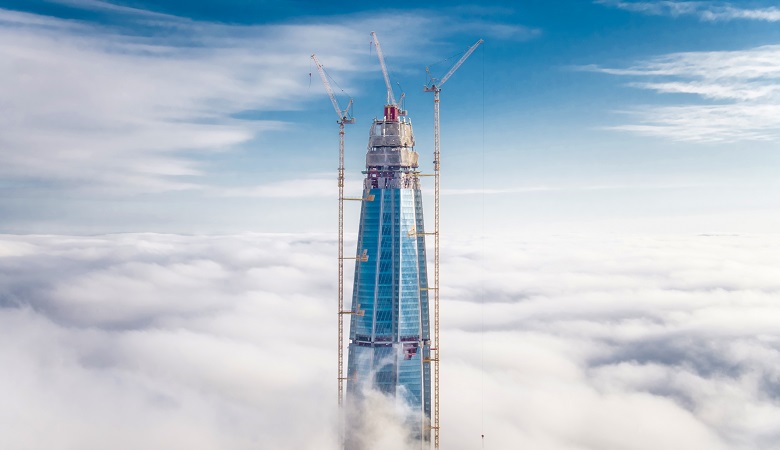
Achieving the planned 462 meters is even less interesting than the current height - after all, there is simply no one else to compete in its category and geographical area. We use this date to speak frankly about height. Is it true that advanced Europeans are already or not building at all? And why is Lakhta Center - after all, his “eminence”, and not “long-term”, as many regularly offer? Nod to the Statoil or Yabloko building? They wrote about the meaninglessness of the desire to "the stars"? Welcome under cat.
Global high-altitude competition does not subside for thousands of years. The desire to build higher is a sign not of today, but of civilization in principle. The Egyptians began to race vertically with their pyramids.

The Pyramid of Cheops. Photo M1chu
The pyramid of Cheops since the completion of construction in 2600 BC. slightly slipped to the current 139 meters, but still, until 2013, it would be the tallest building in present-day St. Petersburg. The last wonder of the world has kept the world's high-altitude leadership 4,000 years. At this interval, the ancient kingdoms of the East declined, Rome fell and the “Dark Ages”winter came with their cold and degeneration of cities.
But as soon as civilization took a step forward, the buildings again rushed up. This time - in Europe, where the main focus of development has moved.
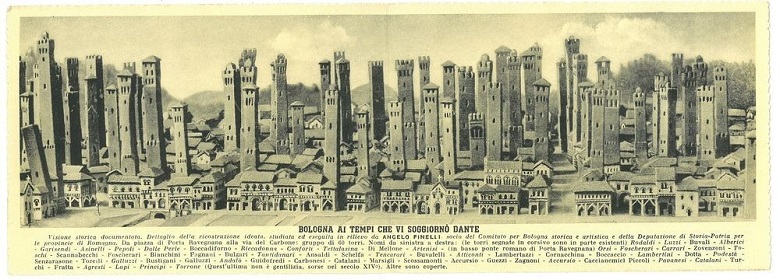
Medieval towers of Bologna. In the heyday of the XII-XIII centuries, their number reached 180, 20 survived, incl. Azinelli (97 m) and Garizenda (48 m). A source
On a large time interval, the height limits that builders could reach with the then arsenal of tools were in the range of 140-160 meters.
In 1311, the Lincoln Cathedral in England was built - 160 meters high. It was built quickly - in just 126 years - and in fact it was the era of great protracted construction, when it was 6 centuries - quite acceptable. Lead a long time - 238 years. The “developer” of the project, Bishop Hugo Lincoln, received the highest honor: canonized.

Wenceslaus Hollar . Lincoln Cathedral with spiers on the western towers. 17th century drawing
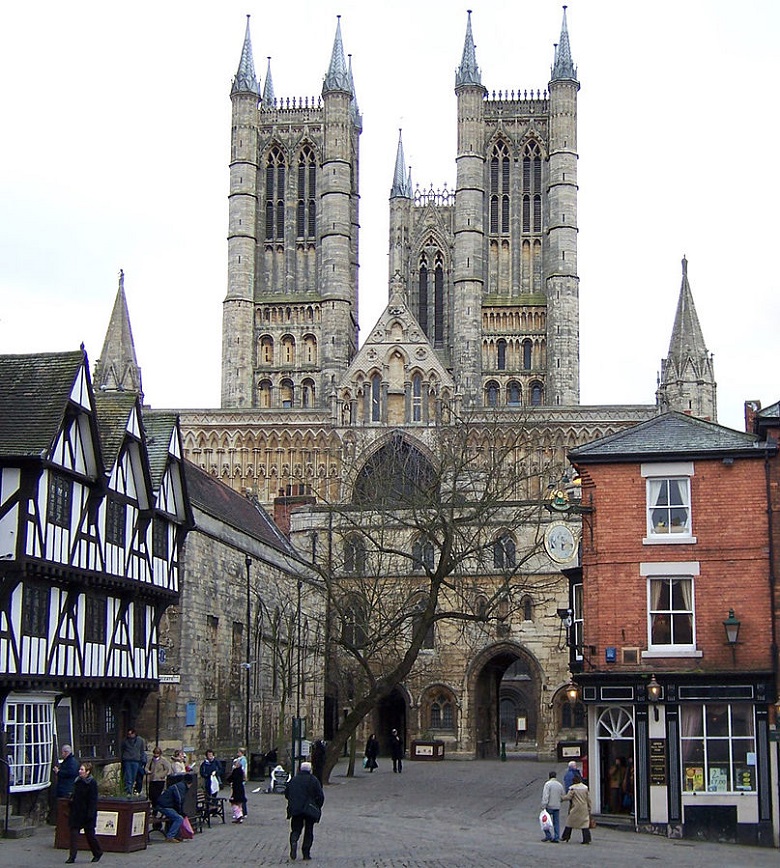
Lincoln Cathedral, a modern look. England, Lincoln. Photographer - Jungpionier
Limited technologies make an amendment to the medieval high-altitude competition, unable to cope convincingly with the elements and the height itself. The next hundred years, it develops as the amazing story of Benjamin Button. A spire collapsed at the 160-meter-high Lincoln Cathedral in 1549, and the Church of St. Olaf in Tallinn with 159 meters tall. She was also let down by a spire - lightning struck at it and caused a fire.

Church of St. Olaf, modern look. Estonia, Tallinn. The spire was restored, but not to the original height. Photographer - Olga Itenberg
The next leader is 150 meters, the church of sv. Maria in Strasuld (Germany). The same story - the spire, lightning, fire. On the question of whether the spiers used to be lightning rods. Rather, too - thunderbrids. Further - less. Strasbourg Cathedral - 142 meters. It seems, indeed, Europe has ceased to chase up?
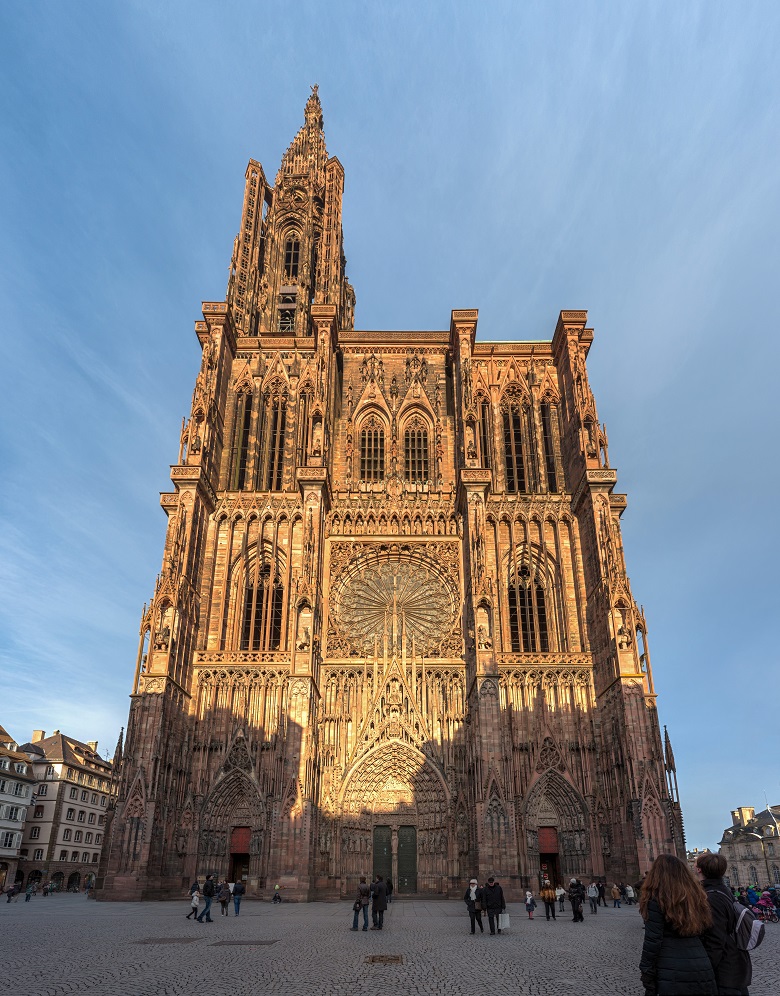
Strasbourg Cathedral. Strasbourg, France. Photographer - Diliff
Do not rush, she just gathered with the forces. 147.3 m. Took the church of sv. Nicholas in Hamburg in 1874, already after a couple of years, it was overtaken by almost four meters by the Rouen Cathedral, and that by six - by Cologne. And then something happened.

Cologne Cathedral. Germany, Cologne. Here it is, the last giant of the passing era. Photographer - Thomas Wolf
1884 New World is crowding Europe: Washington Monument - 169.3 meters in height. Yes, it is an obelisk, not a complex building. But this is a bid. The fact that the star of another center of human civilization rises. Application height. Then there was another structure in Europe, which Gustave Eiffel simply called the “300-meter tower”. And then the high-altitude leadership irrevocably left the Old World.
High-rise buildings in a centuries-old slice show that they are highly built where “human capital” and technology allows. On high-rise buildings, you can trace the centers of civilization and their dynamics. Today, New York, Tokyo and Chinese Hong Kong are leading in the list of cities with the largest number of skyscrapers - the first, second and third economies of the world. The quintessence of resources and technologies, embodied in the urban landscape of modern points of growth of civilization.
Yes, and the highest cathedral on the planet, Ulmsky (161.7 m), has never been a leader.
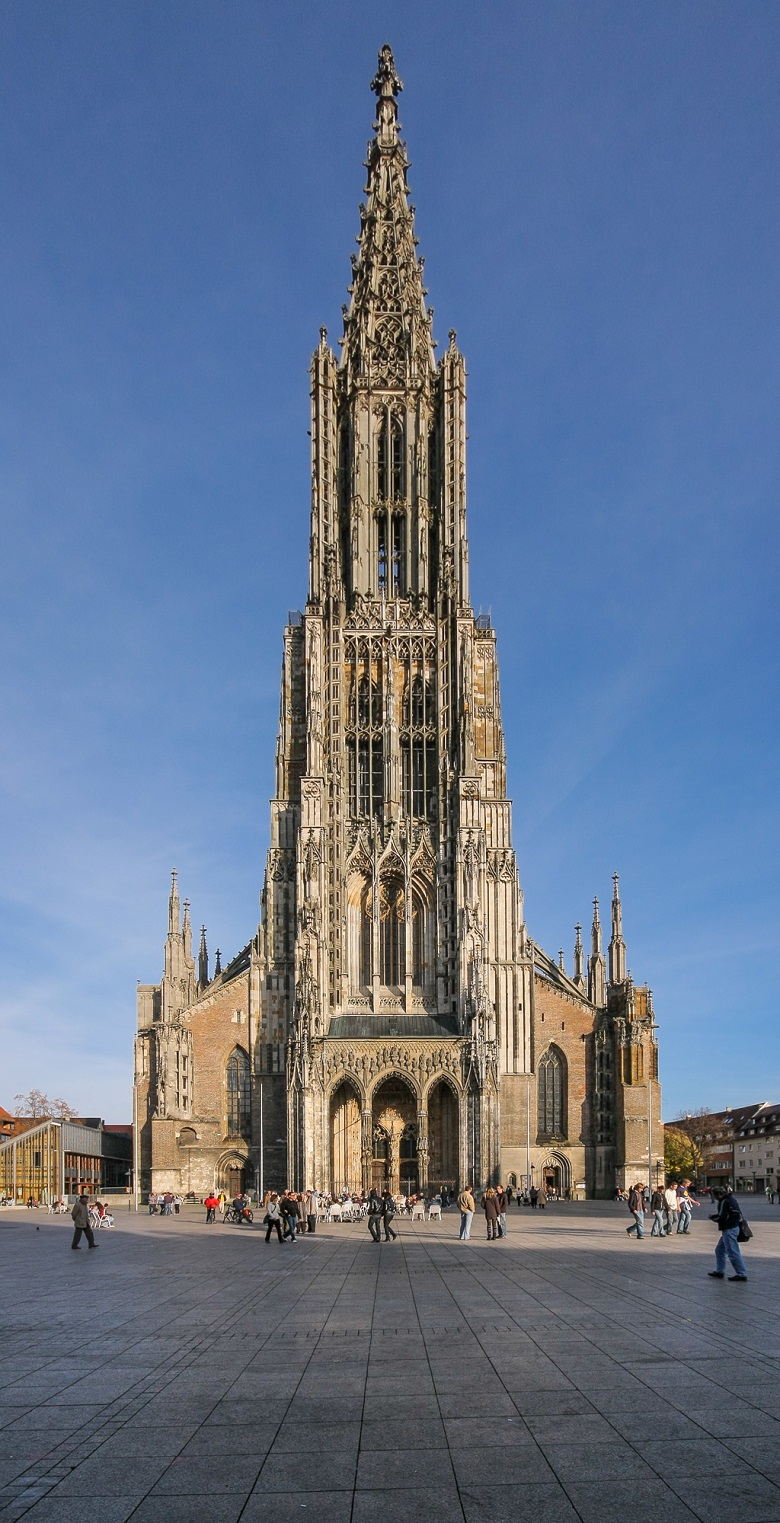
Ulm Cathedral. Germany, Ulm. Above all to God. Photographer - Martin Kraft
It began to be built in 1392, and was completed in 1890. They were only six years late for the championship. And in 1889, the technologies changed at all - the Eiffel Tower with 300 meters left far behind all the Gothic cathedrals of the world. In 1930, the era of skyscrapers began - new super-high buildings with a steel frame, which allowed to go up. The epoch of secular buildings that have suppressed religious ones. Well, even higher office and residential skyscrapers have become the masts of TV towers. On the one hand - technical necessity. On the other - in Peleuvenski symbolic.
By the way, high-rise Gothic architecture is exceptionally good. Do not find
In Japan, there is little land, in China - a lot of people, and the Americans ... they have a national dish - a hamburger! They have specific tastes. Here in Europe they know a lot, and do not build skyscrapers. As the gothic ended, so ceased. Or not?
Since today we are discussing such an event, it will not be boasting to recall the path of the Lakhta Center tower to the highest mark on the European continent.

Timeline construction of the tower from September 2015 to September 2017
The floor construction started at the end of August 2015, the first major milestone occurred less than a year later - June 27, 2016. The core broke 147 meters, the Lakhta Center became the tallest building in St. Petersburg. A couple of weeks later, the skyscraper overtook the tallest building in Belgium - the Tour du Midi located in Brussels. 150 meters of growth, commissioned in 1967. By the same July, Maastoren bypassed 164.75 meters, Rotterdam, the Netherlands. The building was recently built - in 2010.
The highest in Switzerland - Roche Turm Bau 1, 178 m. Built in 2015, bypassed in August 2016. At the same time - the highest in Sweden, Turning Torso from 190 m. Also new building - commissioned in 2005.
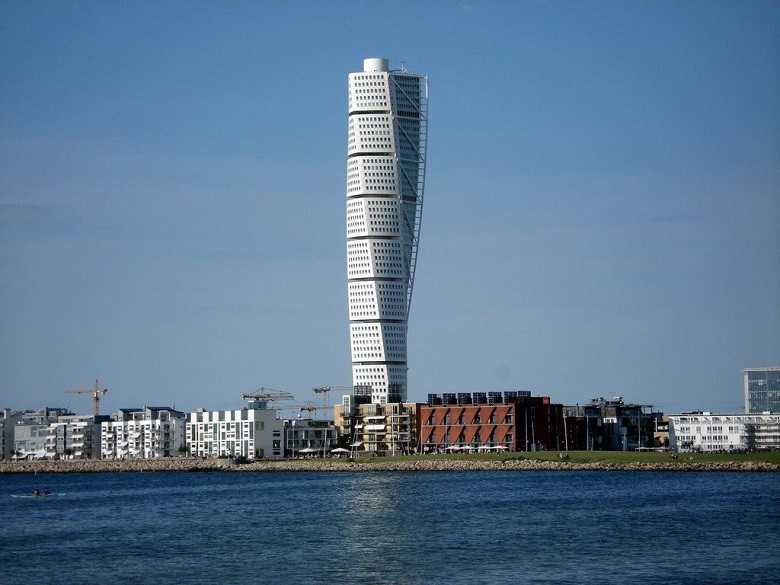
Turning Torso. Sweden, Malmo. Skyscraper in Sweden - did not expect)? Photo from here
Italy’s tallest building, UniCredit Tower in Milan, is 217.7 m tall, built in 2012, walked around in October 2016. At the same time, they overtook Tour First, France’s tallest skyscraper after renovation in 2011, when it was added 72 meters to the existing 159.
Warsaw Palace of Culture and Science overtook either in October or in November.
The structural height of the palace is 230.7 m, according to the Emporis and Skyscraper. But the Poles themselves insist on 237 meters. In their opinion, the antenna must be counted in the footage, because it is " an integral part of the spire ." I cite as an illustrative illustration of the question of whether Europeans are chasing height.

Palace of Culture and Science. Poland Warsaw. On the one hand, the construct is constructive, the hat on the head will not make it higher. On the other - to distinguish where the spire is still, and where the antenna is already really not easy. Photographer - Marina Globetrotter
January 2017 - bypassed the Spaniards from Torre de Cristal, 250 meters high and 2008 year of construction.
April - we overtake the Germans from Commerzbank Tower - 259 meters, built in 1997. On the day of astronautics - English The Shard, 306 meters and 2013 year of construction. All heights are given by constructive.
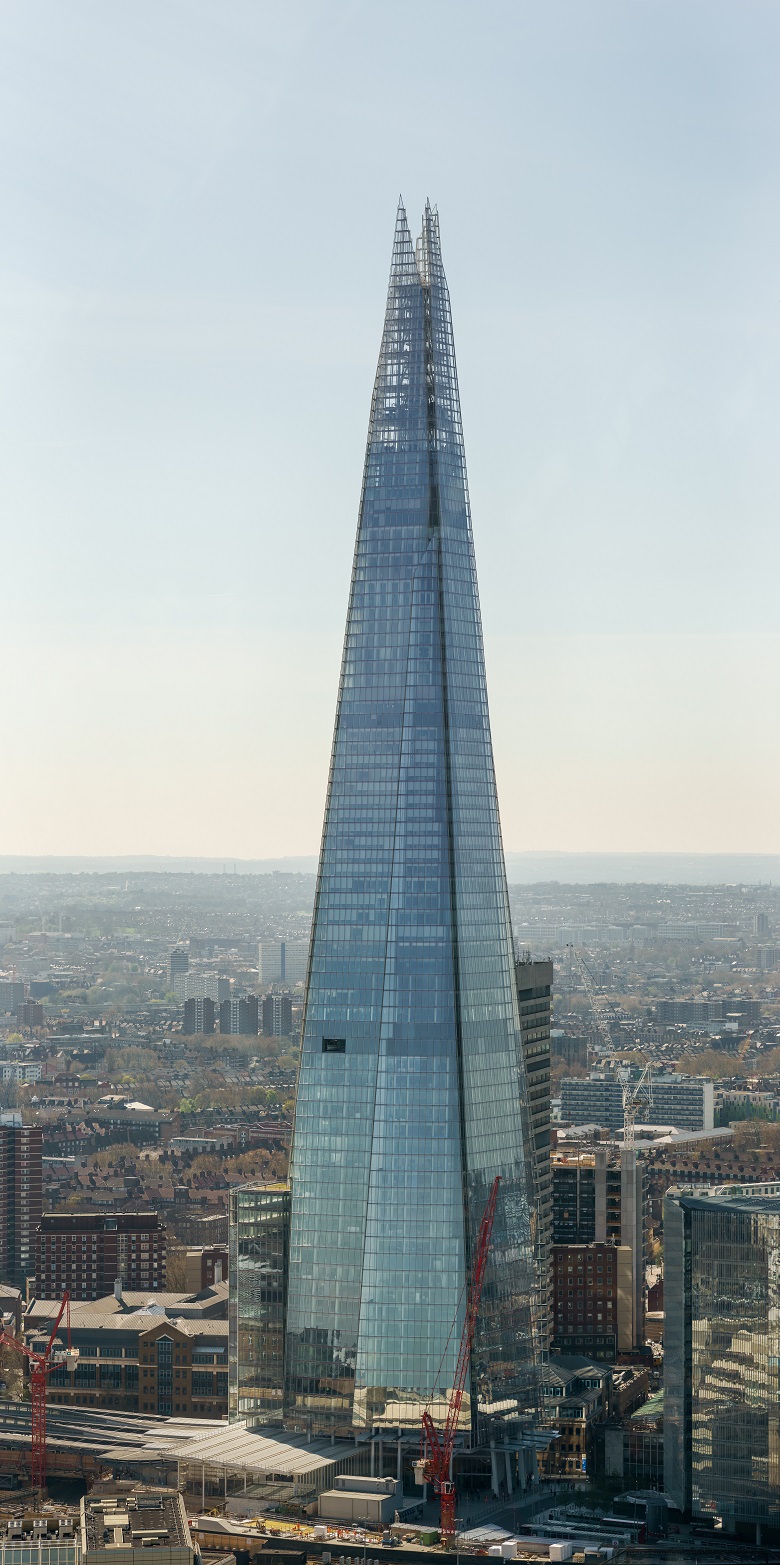
The Shard. Great Britain, London. Photographer - Colin
As you can see, there are skyscrapers in all major European countries. And this is by no means the buildings of the Gothic period, but modern new buildings. So high-rise construction in Europe has not gone anywhere.
But what about the headquarters of Statoil in Oslo, which they like to cite as an example of the “right” architecture of the headquarters of oil and gas corporations?
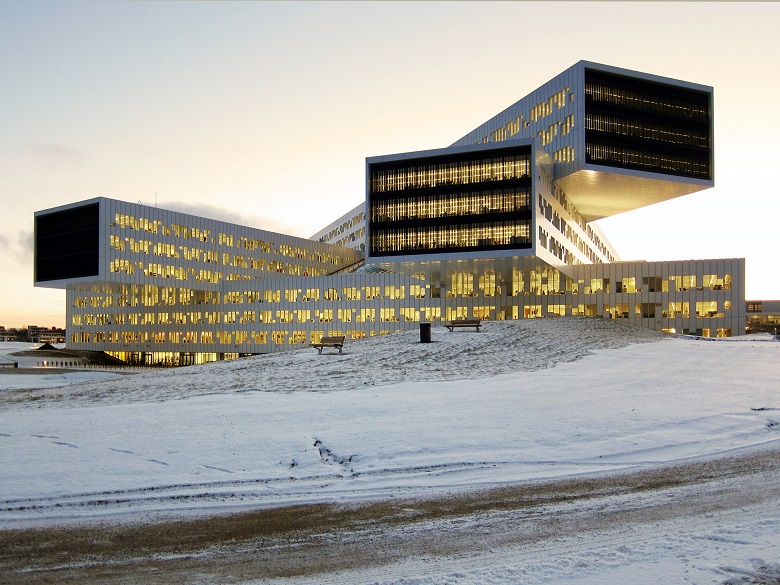
Headquarters Statiol. Norway, Oslo. It seems a bit like a skyscraper broken and folded in a heap? Photo from here .
Scandinavian and, in particular, Norwegian culture and history lie in a different layer of the human background and worldview than the Russian one. No worse and no better - just another. Although the Vikings had long plagued Europe, Norway itself never claimed the role of a great power - even now, when the oil age had turned one of the poorest countries of the Old World into one of the richest in the world. In the Scandinavian culture, it is customary not to stand out and be “not too much” - which is antagonistic to the breadth and scope, which the classics attributed to our compatriots not without reason. Which one is better than the other? And nothing. Just be the first to fly into space, defeat the invincibles, invent the technology for extracting shale oil (that's why ?!) - somewhere in the same row of causes and consequences with the construction of the most outstanding building in Europe. This is practically the dictates of our collective consciousness.
In Japan, 127 million people live on four small islands. Where to go, except to the top?
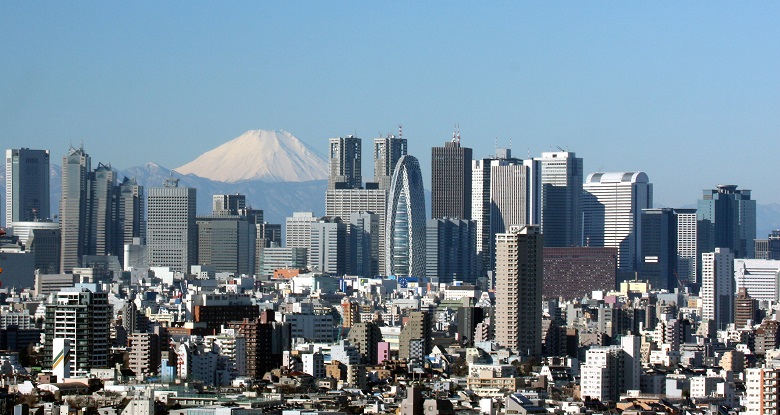
Skyscrapers in Tokyo. Photographer - Morio
And in Russia there is so much land, why build skyscrapers? Well, who has already acquired his Far Eastern hectares? The fact of the matter is that the earth itself and the earth, where there are communications, people and life in principle, are two different worlds. You cannot build a skyscraper in a taiga swamp, and you don’t need it, but in Petersburg you can and should.
When an example is a project like an apple campus, is the context considered? Cupertino is a small town in Silicon Valley. For 60 thousand people - 19 primary schools, 5 secondary schools and 4 high schools. Of these four, two are the best in the state, and two are simply the best on the coast. Educational institutions are simply an indicator of the quality and level of infrastructure development that meets the requirements of wealthy California families. And Apple employees.
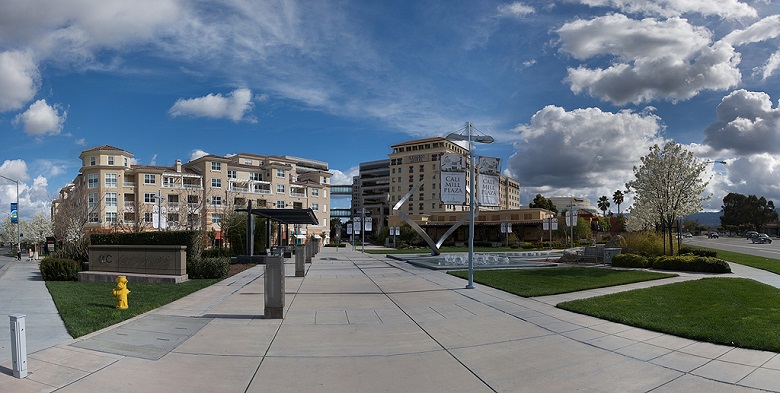
Cupertino, Silicon Valley, California, USA. Photographer - Antipex
Apple will occupy 71 hectares and build on it only 260,000 m2 of real estate. In Silicon Valley, you can get not only a plot that allows you to build a separate town instead of a compact headquarters, but also a good standard of living outside the campus walls. In Russia, the conventional "development of Siberia" with the most severe climatic conditions and low population density in vast territories is a centuries-old task - from tsarist times and for a long time.
Moscow from a small military border point on the site of the village Kuchkovo for 870 years has become the largest in Europe agglomeration area from 13,000 to 26,000 square meters. km. (the last figure is the data of the “Agglomeration. World. Russia. Moscow” research , 2017).
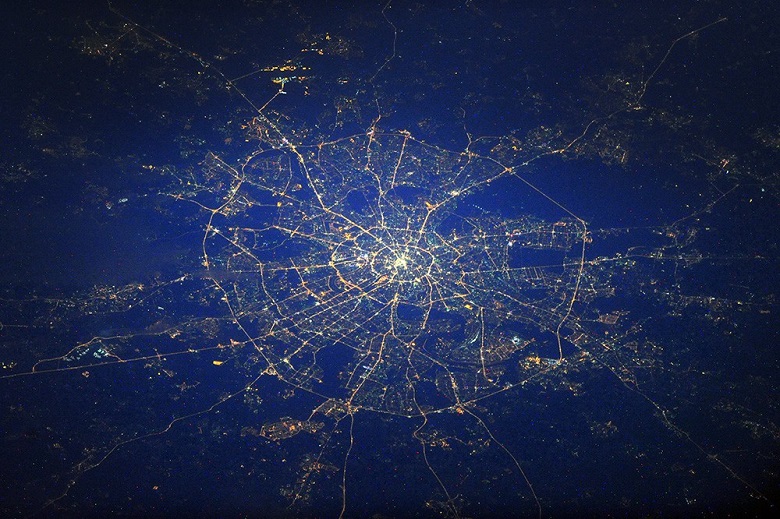
Moscow from space. A snapshot of the Russian Space Agency
Further trends are the formation of the central megalopolis, which absorbs the Tula-Novomoskovsk junction, Yaroslavl, Kostroma, Ivanovo, Nizhny Novgorod, Tver, Kaluga, Ryazan, I don’t remember all ... There is a theory that sooner or later the agglomeration Moscow-St. Petersburg will form. There are about 450 agglomerations in the world. The growth process of urbanized areas is swift. According to a UN report, as many as 746 million people lived in cities back in the 1950s, now 3.5 billion. In the next 30 years, the figure will almost double - predict plus 2.5 billion. The number of megacities with a population of over 10 million from 10 1990 rose to 28 in 2014, in the next 13 years there will be 41 of them.
Petersburg itself from 5 historical districts has grown to 18.
Modern cities are actively expanding in breadth. We need more houses, more roads, more cars.
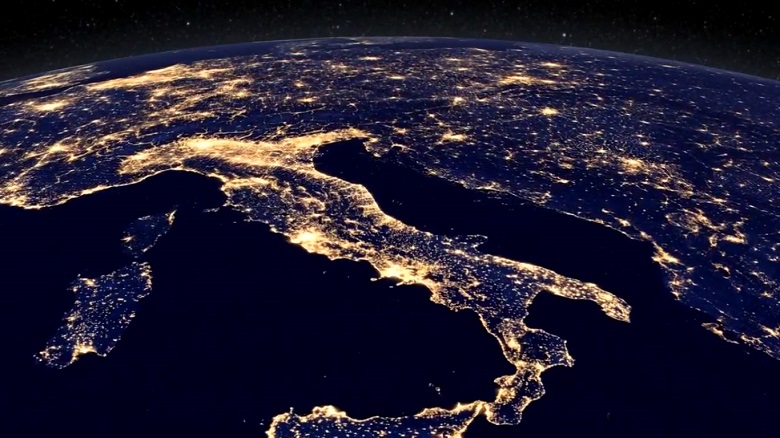
Earth New Year's Eve. NASA image from space
In addition to the specific problems of the actual urbanized environment — for example, traffic jams to which songs are already devoted, there are more global problems — we are pushing aside the natural environment. It is not clear to what extent the process can go without irreversible consequences.
Perhaps, in such a context, high-rise construction, which allows compactly accommodating many, is this a good way out? If you do not exaggerate and do not cite the worst examples, such as:

Hong Kong from Photocycle Architecture of density Michael Wolf. Photo from here.
And focus on the beautiful high-rise buildings. Here is a panorama from England, for example:
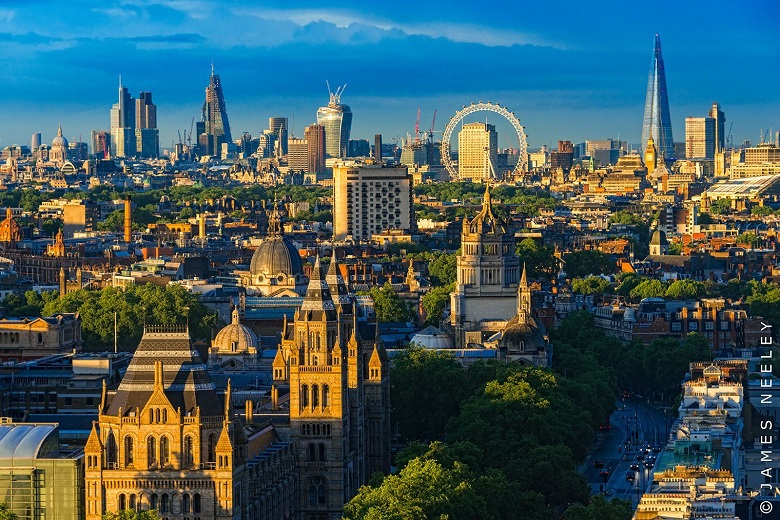
London Skyline, fthorkhoff - James Neeley , on Flickr
Or from Vienna:
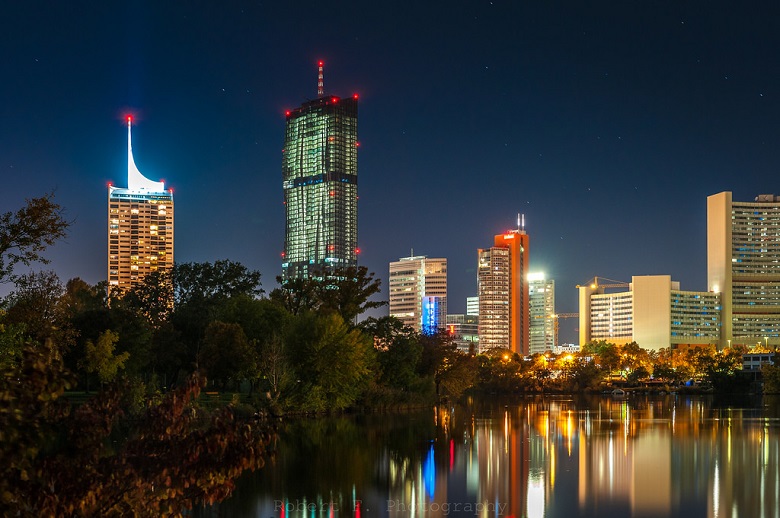
Kaiserwasser, photo - Robert F. Photography , on Flickr
By and large, we on planet Earth are all like those Japanese on our four small islands in the Pacific Ocean. Sooner or later, population growth and the need to limit urban areas will not leave us a choice. So, no - skyscrapers are not the last century, but the future. It makes sense to overcome the laws of physics and "heroically" build high-rise buildings. Sometime it will become commonplace. And we are now - as the first astronauts)).
-
Clip to date. On the video - the real shot, not animation

Achieving the planned 462 meters is even less interesting than the current height - after all, there is simply no one else to compete in its category and geographical area. We use this date to speak frankly about height. Is it true that advanced Europeans are already or not building at all? And why is Lakhta Center - after all, his “eminence”, and not “long-term”, as many regularly offer? Nod to the Statoil or Yabloko building? They wrote about the meaninglessness of the desire to "the stars"? Welcome under cat.
Who started it all
Global high-altitude competition does not subside for thousands of years. The desire to build higher is a sign not of today, but of civilization in principle. The Egyptians began to race vertically with their pyramids.

The Pyramid of Cheops. Photo M1chu
The pyramid of Cheops since the completion of construction in 2600 BC. slightly slipped to the current 139 meters, but still, until 2013, it would be the tallest building in present-day St. Petersburg. The last wonder of the world has kept the world's high-altitude leadership 4,000 years. At this interval, the ancient kingdoms of the East declined, Rome fell and the “Dark Ages”
But as soon as civilization took a step forward, the buildings again rushed up. This time - in Europe, where the main focus of development has moved.

Medieval towers of Bologna. In the heyday of the XII-XIII centuries, their number reached 180, 20 survived, incl. Azinelli (97 m) and Garizenda (48 m). A source
The era of great protracted
On a large time interval, the height limits that builders could reach with the then arsenal of tools were in the range of 140-160 meters.
In 1311, the Lincoln Cathedral in England was built - 160 meters high. It was built quickly - in just 126 years - and in fact it was the era of great protracted construction, when it was 6 centuries - quite acceptable. Lead a long time - 238 years. The “developer” of the project, Bishop Hugo Lincoln, received the highest honor: canonized.

Wenceslaus Hollar . Lincoln Cathedral with spiers on the western towers. 17th century drawing

Lincoln Cathedral, a modern look. England, Lincoln. Photographer - Jungpionier
Limited technologies make an amendment to the medieval high-altitude competition, unable to cope convincingly with the elements and the height itself. The next hundred years, it develops as the amazing story of Benjamin Button. A spire collapsed at the 160-meter-high Lincoln Cathedral in 1549, and the Church of St. Olaf in Tallinn with 159 meters tall. She was also let down by a spire - lightning struck at it and caused a fire.

Church of St. Olaf, modern look. Estonia, Tallinn. The spire was restored, but not to the original height. Photographer - Olga Itenberg
The next leader is 150 meters, the church of sv. Maria in Strasuld (Germany). The same story - the spire, lightning, fire. On the question of whether the spiers used to be lightning rods. Rather, too - thunderbrids. Further - less. Strasbourg Cathedral - 142 meters. It seems, indeed, Europe has ceased to chase up?

Strasbourg Cathedral. Strasbourg, France. Photographer - Diliff
Do not rush, she just gathered with the forces. 147.3 m. Took the church of sv. Nicholas in Hamburg in 1874, already after a couple of years, it was overtaken by almost four meters by the Rouen Cathedral, and that by six - by Cologne. And then something happened.

Cologne Cathedral. Germany, Cologne. Here it is, the last giant of the passing era. Photographer - Thomas Wolf
1884 New World is crowding Europe: Washington Monument - 169.3 meters in height. Yes, it is an obelisk, not a complex building. But this is a bid. The fact that the star of another center of human civilization rises. Application height. Then there was another structure in Europe, which Gustave Eiffel simply called the “300-meter tower”. And then the high-altitude leadership irrevocably left the Old World.
High-rise buildings in a centuries-old slice show that they are highly built where “human capital” and technology allows. On high-rise buildings, you can trace the centers of civilization and their dynamics. Today, New York, Tokyo and Chinese Hong Kong are leading in the list of cities with the largest number of skyscrapers - the first, second and third economies of the world. The quintessence of resources and technologies, embodied in the urban landscape of modern points of growth of civilization.
Yes, and the highest cathedral on the planet, Ulmsky (161.7 m), has never been a leader.

Ulm Cathedral. Germany, Ulm. Above all to God. Photographer - Martin Kraft
It began to be built in 1392, and was completed in 1890. They were only six years late for the championship. And in 1889, the technologies changed at all - the Eiffel Tower with 300 meters left far behind all the Gothic cathedrals of the world. In 1930, the era of skyscrapers began - new super-high buildings with a steel frame, which allowed to go up. The epoch of secular buildings that have suppressed religious ones. Well, even higher office and residential skyscrapers have become the masts of TV towers. On the one hand - technical necessity. On the other - in Peleuvenski symbolic.
By the way, high-rise Gothic architecture is exceptionally good. Do not find
And in Europe they do not build like this
In Japan, there is little land, in China - a lot of people, and the Americans ... they have a national dish - a hamburger! They have specific tastes. Here in Europe they know a lot, and do not build skyscrapers. As the gothic ended, so ceased. Or not?
Since today we are discussing such an event, it will not be boasting to recall the path of the Lakhta Center tower to the highest mark on the European continent.

Timeline construction of the tower from September 2015 to September 2017
The floor construction started at the end of August 2015, the first major milestone occurred less than a year later - June 27, 2016. The core broke 147 meters, the Lakhta Center became the tallest building in St. Petersburg. A couple of weeks later, the skyscraper overtook the tallest building in Belgium - the Tour du Midi located in Brussels. 150 meters of growth, commissioned in 1967. By the same July, Maastoren bypassed 164.75 meters, Rotterdam, the Netherlands. The building was recently built - in 2010.
The highest in Switzerland - Roche Turm Bau 1, 178 m. Built in 2015, bypassed in August 2016. At the same time - the highest in Sweden, Turning Torso from 190 m. Also new building - commissioned in 2005.

Turning Torso. Sweden, Malmo. Skyscraper in Sweden - did not expect)? Photo from here
Italy’s tallest building, UniCredit Tower in Milan, is 217.7 m tall, built in 2012, walked around in October 2016. At the same time, they overtook Tour First, France’s tallest skyscraper after renovation in 2011, when it was added 72 meters to the existing 159.
Warsaw Palace of Culture and Science overtook either in October or in November.
The structural height of the palace is 230.7 m, according to the Emporis and Skyscraper. But the Poles themselves insist on 237 meters. In their opinion, the antenna must be counted in the footage, because it is " an integral part of the spire ." I cite as an illustrative illustration of the question of whether Europeans are chasing height.

Palace of Culture and Science. Poland Warsaw. On the one hand, the construct is constructive, the hat on the head will not make it higher. On the other - to distinguish where the spire is still, and where the antenna is already really not easy. Photographer - Marina Globetrotter
January 2017 - bypassed the Spaniards from Torre de Cristal, 250 meters high and 2008 year of construction.
April - we overtake the Germans from Commerzbank Tower - 259 meters, built in 1997. On the day of astronautics - English The Shard, 306 meters and 2013 year of construction. All heights are given by constructive.

The Shard. Great Britain, London. Photographer - Colin
As you can see, there are skyscrapers in all major European countries. And this is by no means the buildings of the Gothic period, but modern new buildings. So high-rise construction in Europe has not gone anywhere.
But what about the headquarters of Statoil in Oslo, which they like to cite as an example of the “right” architecture of the headquarters of oil and gas corporations?

Headquarters Statiol. Norway, Oslo. It seems a bit like a skyscraper broken and folded in a heap? Photo from here .
Scandinavian and, in particular, Norwegian culture and history lie in a different layer of the human background and worldview than the Russian one. No worse and no better - just another. Although the Vikings had long plagued Europe, Norway itself never claimed the role of a great power - even now, when the oil age had turned one of the poorest countries of the Old World into one of the richest in the world. In the Scandinavian culture, it is customary not to stand out and be “not too much” - which is antagonistic to the breadth and scope, which the classics attributed to our compatriots not without reason. Which one is better than the other? And nothing. Just be the first to fly into space, defeat the invincibles, invent the technology for extracting shale oil (that's why ?!) - somewhere in the same row of causes and consequences with the construction of the most outstanding building in Europe. This is practically the dictates of our collective consciousness.
Land issue
In Japan, 127 million people live on four small islands. Where to go, except to the top?

Skyscrapers in Tokyo. Photographer - Morio
And in Russia there is so much land, why build skyscrapers? Well, who has already acquired his Far Eastern hectares? The fact of the matter is that the earth itself and the earth, where there are communications, people and life in principle, are two different worlds. You cannot build a skyscraper in a taiga swamp, and you don’t need it, but in Petersburg you can and should.
When an example is a project like an apple campus, is the context considered? Cupertino is a small town in Silicon Valley. For 60 thousand people - 19 primary schools, 5 secondary schools and 4 high schools. Of these four, two are the best in the state, and two are simply the best on the coast. Educational institutions are simply an indicator of the quality and level of infrastructure development that meets the requirements of wealthy California families. And Apple employees.

Cupertino, Silicon Valley, California, USA. Photographer - Antipex
Apple will occupy 71 hectares and build on it only 260,000 m2 of real estate. In Silicon Valley, you can get not only a plot that allows you to build a separate town instead of a compact headquarters, but also a good standard of living outside the campus walls. In Russia, the conventional "development of Siberia" with the most severe climatic conditions and low population density in vast territories is a centuries-old task - from tsarist times and for a long time.
Big cities
Moscow from a small military border point on the site of the village Kuchkovo for 870 years has become the largest in Europe agglomeration area from 13,000 to 26,000 square meters. km. (the last figure is the data of the “Agglomeration. World. Russia. Moscow” research , 2017).

Moscow from space. A snapshot of the Russian Space Agency
Further trends are the formation of the central megalopolis, which absorbs the Tula-Novomoskovsk junction, Yaroslavl, Kostroma, Ivanovo, Nizhny Novgorod, Tver, Kaluga, Ryazan, I don’t remember all ... There is a theory that sooner or later the agglomeration Moscow-St. Petersburg will form. There are about 450 agglomerations in the world. The growth process of urbanized areas is swift. According to a UN report, as many as 746 million people lived in cities back in the 1950s, now 3.5 billion. In the next 30 years, the figure will almost double - predict plus 2.5 billion. The number of megacities with a population of over 10 million from 10 1990 rose to 28 in 2014, in the next 13 years there will be 41 of them.
Petersburg itself from 5 historical districts has grown to 18.
Modern cities are actively expanding in breadth. We need more houses, more roads, more cars.

Earth New Year's Eve. NASA image from space
In addition to the specific problems of the actual urbanized environment — for example, traffic jams to which songs are already devoted, there are more global problems — we are pushing aside the natural environment. It is not clear to what extent the process can go without irreversible consequences.
Perhaps, in such a context, high-rise construction, which allows compactly accommodating many, is this a good way out? If you do not exaggerate and do not cite the worst examples, such as:

Hong Kong from Photocycle Architecture of density Michael Wolf. Photo from here.
And focus on the beautiful high-rise buildings. Here is a panorama from England, for example:

London Skyline, fthorkhoff - James Neeley , on Flickr
Or from Vienna:

Kaiserwasser, photo - Robert F. Photography , on Flickr
By and large, we on planet Earth are all like those Japanese on our four small islands in the Pacific Ocean. Sooner or later, population growth and the need to limit urban areas will not leave us a choice. So, no - skyscrapers are not the last century, but the future. It makes sense to overcome the laws of physics and "heroically" build high-rise buildings. Sometime it will become commonplace. And we are now - as the first astronauts)).
-
Clip to date. On the video - the real shot, not animation
All Articles